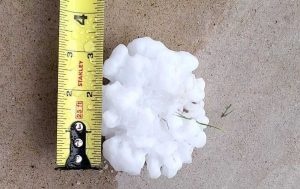June was a fairly active month for severe weather in North Texas, but there’s little rainfall to show for it. As the month ended, oppressive heat was becoming the rule.
As of June 25th Denton County’s average high of 94 was about 3 degrees warmer than the historic average of 91. The hottest daily maximum was 102 on June 25th, while the coolest maximum was 77 during a storm event on June 13th. The coolest low temperature was 61 on June 4th, while the warmest overnight low was 82 on June 20th. The day-night average temperature was 69.4, just barely above the climatological norm of 69.
Rainfall was disappointing. Again. Half an inch of rain (.47) was recorded on June 5th, while .05” fell on the 12th. The best rain of the month, (.61”) was received on the 21st. Total for the month was 1.14”, less than half the June average of 3.22”. With May’s total of only 1.4 inches, the total rainfall so far in 2023 is only 10.9”, compared to average year-to-date rainfall of 18.79 inches. Things are getting serious.

A brief but significant thunderstorm damaged some roofs and vehicles in southern Denton County on the evening of June 11th. The rogue storm dumped hail as large as baseballs on parts of Flower Mound, Bartonville, Lantana, Highland Village and Lewisville, causing damage to some homes and vehicles.
The worst severe weather outbreak was a mid-month swarm of violent thunderstorms that stretched from Texas to Florida, covering six states. The first and worst victim was the Panhandle town of Perryton, which was decimated by an EF-3 tornado on June 15, injuring dozens and killing three residents. Despite all that, in the past 30 years, more Americans have died as a result of excessive heat than from tornadoes and hurricanes combined.
The Climate Prediction Center forecasts the next 1-3 months will be warmer than normal while rainfall is forecast to be only near average across most of Texas.
To help make the heat more survivable, try these low-tech tactics: Limit time outdoors to between 1 and 8 p.m. Spray down the west side of your home with a garden hose just after sunset to help kill the solar heat moving through your bricks or siding, (Arizona homeowners have rooftop sprinklers to do the same thing). Spray down the outside of your A/C compressor (gently, while turned off) to clean dust and cottonwood fiber from your coils. Use a windshield reflector to reflect solar heat from your dashboard (which can reach 190 degrees). If you can’t fully pay your electric bill, contact your provider. They’ll usually work something out. Take care of you and yours first.






.jpg)





.jpg)


